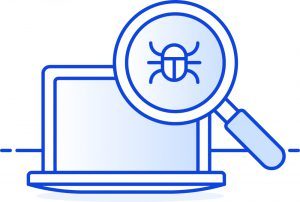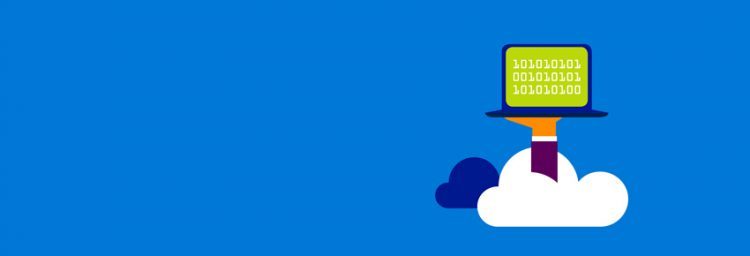The 5 most common types of cyber attacks

Increasingly, companies are faced with cyber incidents - both small and medium-sized enterprises, and large organizations. What types of cyber attacks can endanger your business?
Download the entire cybersecurity e-book
Types of cyber attacks continue to increase
 As a company in today's society, it is best to ensure that you can also offer your goods and/or services digitally. More and more companies are making the step towards a digital presence for business continuity. However, there is a downside to this transition: cyber criminals target their attacks on the IT systems and the digital data they collect.
As a company in today's society, it is best to ensure that you can also offer your goods and/or services digitally. More and more companies are making the step towards a digital presence for business continuity. However, there is a downside to this transition: cyber criminals target their attacks on the IT systems and the digital data they collect.
The number of attacks, including on small and medium-sized enterprises, is increasing. And the attacks themselves are becoming more sophisticated, with more advanced tactics. An overview of the most common types of cyber attacks can help you arm yourself against these threats. Based on general trends, Techpulse.be drew up a list of the methods most often used by cyber criminals.
1. Malware
Malware is a form of software used by hackers to disrupt computer systems, gather sensitive information or break into computer systems. Trojans (software is smuggled into your system unnoticed, packaged in another software), viruses (via infected downloads or mail attachments), worms (software that exploits leaks in systems to spread automatically), adware (publicity displayed on your screen after you have installed a certain program) and spyware (a program that follows where you are surfing, even writes down your login details) are all examples of malware. By making use of holes in software programs or infected downloads or links, a hacker can inflict a lot of damage with malware.
One particular form of malware we are seeing more and more frequently is ransomware. With a ransomware attack, a hacker encrypts the access to data or systems in exchange for ransom money. Combell fortunately helps you to arm yourself against malware. Because if you have a mailbox with Combell, your mailbox remains free of malicious software and e-mails thanks to our robust spam filter and antivirus.
2. Phishing
Another classic form of Internet fraud in particularly common use today is phishing. In this type of attack, cybercriminals approach their victims via e-mail, text message, telephone or social media to fish for sensitive data, such as personal details, passwords, bank or credit card details. By this means, a hacker may gain access to company computer systems, bank accounts or even the identity of the victim.
Also read about this: What is a phishing e-mail and how can you tell it is a fake email? And Fallen into a phishing trap? This is how to limit the damage.
3. Web-based attacks & web application attacks
 Web-based attacks use web components, like browsers, extensions, CMSs or web servers, to carry out an attack. In this type of attack, hackers are making use of incorrect configurations or weak points in the infrastructure.
Web-based attacks use web components, like browsers, extensions, CMSs or web servers, to carry out an attack. In this type of attack, hackers are making use of incorrect configurations or weak points in the infrastructure.
Web application attacks are related to web-based attacks and make use of vulnerabilities in web applications, but also of leaks in underlying web components, to execute SQL injections for example. A hacker abuses an insufficiently protected input field of a web app in order to smuggle code into the system and execute it. Read more: What is SQL injection and how can you prevent it?
4. Denial of Service (DoS) & Distributed Denial of Service (DDoS)
In Denial of Service attacks, hackers overwhelm computer systems, networks or machines with data or requests. These overload the system or the machine, which eventually crashes, making it inaccessible for users. In a Distributed Denial of Service attack (DDoS) multiple computers carry out this attack simultaneously. DoS or DDoS attacks can have a huge impact on businesses. They translate to an unusually slow network, the unavailability or inaccessibility of a website and a huge increase in the number of spam e-mails.
These types of cyber attacks can have a very negative impact on your business. Your network becomes very slow, your website is no longer accessible for your customers, and you miss out on sales! Follow our tips in the article How can you protect your website against DDoS attacks?
5. Spam
 Spam too is positioned in the top 5 of the most commonly occurring cyber threats. Spam is a collective term for massive amounts of unwanted e-mail sent out by criminals. Cyber criminals often deploy botnets to send out huge numbers of malicious e-mails with malware.
Spam too is positioned in the top 5 of the most commonly occurring cyber threats. Spam is a collective term for massive amounts of unwanted e-mail sent out by criminals. Cyber criminals often deploy botnets to send out huge numbers of malicious e-mails with malware.
Unfortunately, in recent years, cyber criminals have become increasingly adept at methods of avoiding spam filters. And when the criminals use your domain name as the sender of their emails, this can also have harmful consequences for your company - your domain will be blacklisted and your legitimate emails will no longer be able to reach your customers! Also read our tips to prevent your legitimate mails from being considered spam.


